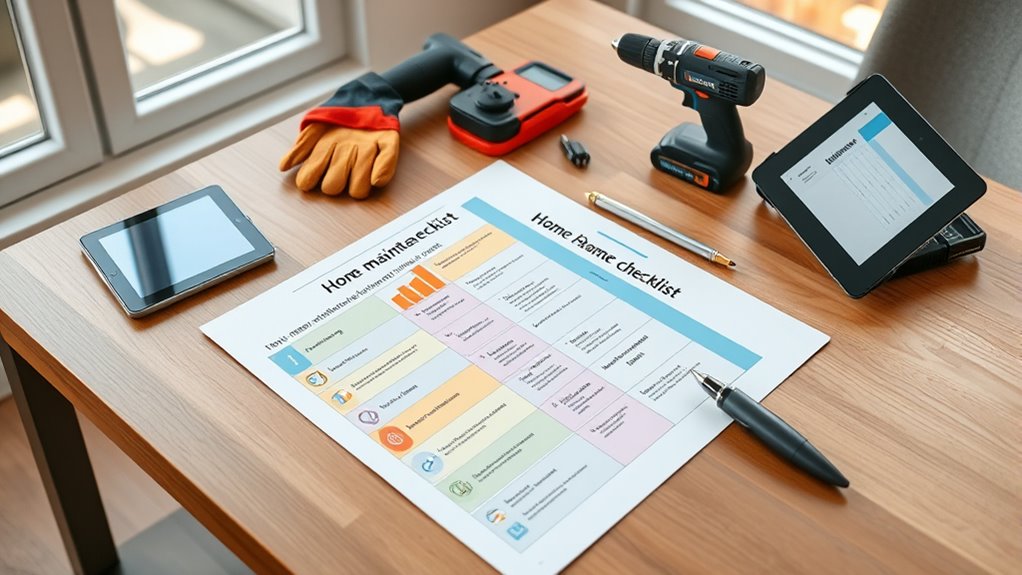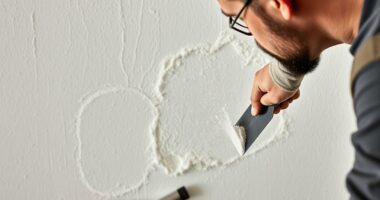As a new homeowner, creating a home maintenance checklist is key to protecting your investment and staying safe. Schedule annual inspections for plumbing and roofs, especially after storms, to catch issues early. Regularly clean gutters, check for leaks, and monitor ceilings for water stains. Incorporate seasonal tasks like inspecting shingles and flashing, and use safety checks to stay ahead of problems. Keeping up with these routines will help you maintain your home’s value and peace of mind as you move forward.
Key Takeaways
- Schedule annual plumbing inspections to detect leaks, mold, and prevent water damage.
- Regularly inspect and maintain the roof, especially after storms, for damaged shingles and flashing issues.
- Incorporate seasonal checks for plumbing and roof health into your routine to catch problems early.
- Keep gutters clean and check structural components to ensure safety and prevent costly repairs.
- Develop a maintenance schedule to consistently monitor and protect your home’s value and safety.

Keeping up with home maintenance can seem overwhelming, but a simple checklist makes it manageable. As a new homeowner, staying on top of essential tasks like plumbing inspections and roof repairs helps prevent costly problems down the line. Regular plumbing inspections allow you to catch leaks, drips, or corrosion early, saving water and avoiding water damage. You should schedule these inspections at least once a year, especially if you notice reduced water pressure or strange noises from your pipes. Check under sinks for leaks, and look out for any foul odors that could indicate mold or sewer issues. Addressing plumbing concerns promptly ensures your system runs smoothly and extends its lifespan.
Regular plumbing inspections prevent leaks and water damage, saving money and extending your system’s lifespan.
Roof repairs are another critical aspect of home maintenance that shouldn’t be overlooked. Your roof protects your entire home from the elements, so inspecting it regularly is essential. After storms or heavy winds, take a moment to check for missing or damaged shingles, as these can lead to leaks if left unattended. Look for signs of wear like curling or cracking shingles, and examine flashing around chimneys and vents for gaps or rust. Maintaining your roof involves not just repairs but also preventive measures, such as cleaning gutters and removing debris that could trap moisture and cause damage. If you notice any issues during your inspections, don’t delay in scheduling repairs. Small problems like loose shingles or minor leaks can escalate quickly, leading to more extensive and expensive repairs later.
Incorporate both plumbing inspections and roof repairs into your seasonal home maintenance routine. These tasks are crucial in preserving your home’s integrity and avoiding emergencies. When inspecting your plumbing, turn on each fixture and check for any irregularities. Keep an eye out for water stains or mold on ceilings and walls, which could indicate hidden leaks. For your roof, use binoculars from the ground if necessary, or hire a professional for a thorough assessment. Remember, early detection keeps repairs manageable and affordable. Additionally, understanding Honda Tuning concepts like suspension upgrades can help you better evaluate your home’s structural components, ensuring safety and longevity.
Making these inspections part of your regular schedule helps you stay proactive rather than reactive. It’s about creating a routine that fits into your life—monthly, quarterly, or seasonally—so nothing gets overlooked. Keeping up with home maintenance isn’t just about fixing problems; it’s about protecting your investment and ensuring your home remains a safe, comfortable place for years to come. With consistency and attention to detail, you’ll develop confidence in managing your home, avoiding surprises, and enjoying peace of mind.
Frequently Asked Questions
How Often Should I Change My HVAC Filters?
You should change your HVAC filters regularly to keep your system running efficiently. Generally, it’s recommended to replace filters every 1 to 3 months, depending on usage and filter type. Regular HVAC maintenance, including filter replacement, prevents dust buildup and improves air quality. If you have pets or allergies, consider changing filters more often. Stay on top of filter replacement to guarantee peak performance and energy savings for your home.
What Is the Best Way to Detect Hidden Water Leaks?
Imagine discovering a hidden water leak before it causes costly damage. Start with a pipe inspection, checking for damp spots or mold. Use moisture detection tools to find subtle signs of leaks behind walls or under floors. Regularly inspecting your plumbing and being attentive to changes in water bills helps catch leaks early. By combining visual checks with moisture detection, you can prevent major repairs and keep your home safe.
When Should I Schedule Roof Inspections?
You should schedule roof inspections at regular intervals to guarantee roof durability and catch potential issues early. Ideally, do a professional inspection twice a year—once in spring and fall—and after severe weather events like storms or heavy snowfall. Regular inspections help identify damage, maintain your roof’s integrity, and extend its lifespan. Staying proactive with inspection timing keeps your home protected and avoids costly repairs down the line.
How Can I Prevent Mold in Bathrooms?
You might think mold prevention in bathrooms is complicated, but it’s simple with the right ventilation tips. Keep your bathroom well-ventilated by running the exhaust fan during and after showers. Use mold-resistant materials like mildew-resistant paint and tiles. Regularly clean surfaces with mold-killing solutions, and fix leaks promptly. These steps help reduce moisture, preventing mold growth and keeping your bathroom fresh and healthy.
What Maintenance Tasks Are Essential Before Winter?
Before winter hits, you should winterize appliances and check outdoor insulation. Make sure to drain and disconnect hoses, shut off exterior water valves, and insulate pipes to prevent freezing. Inspect outdoor electrical outlets and cover them if necessary. Seal gaps around windows and doors to boost energy efficiency. Taking these steps helps protect your home from winter damage, saving you money and stress during the cold months.
Conclusion
Think of your home as a living, breathing partner that needs your care. By staying on top of this maintenance checklist, you’re planting seeds for a strong, healthy house that stands tall through any storm. Regular upkeep keeps your home singing its sweet song of comfort and safety. So, embrace these tasks like a gardener tending to precious blooms—your efforts will blossom into a cozy, worry-free haven you’ll cherish for years to come.









